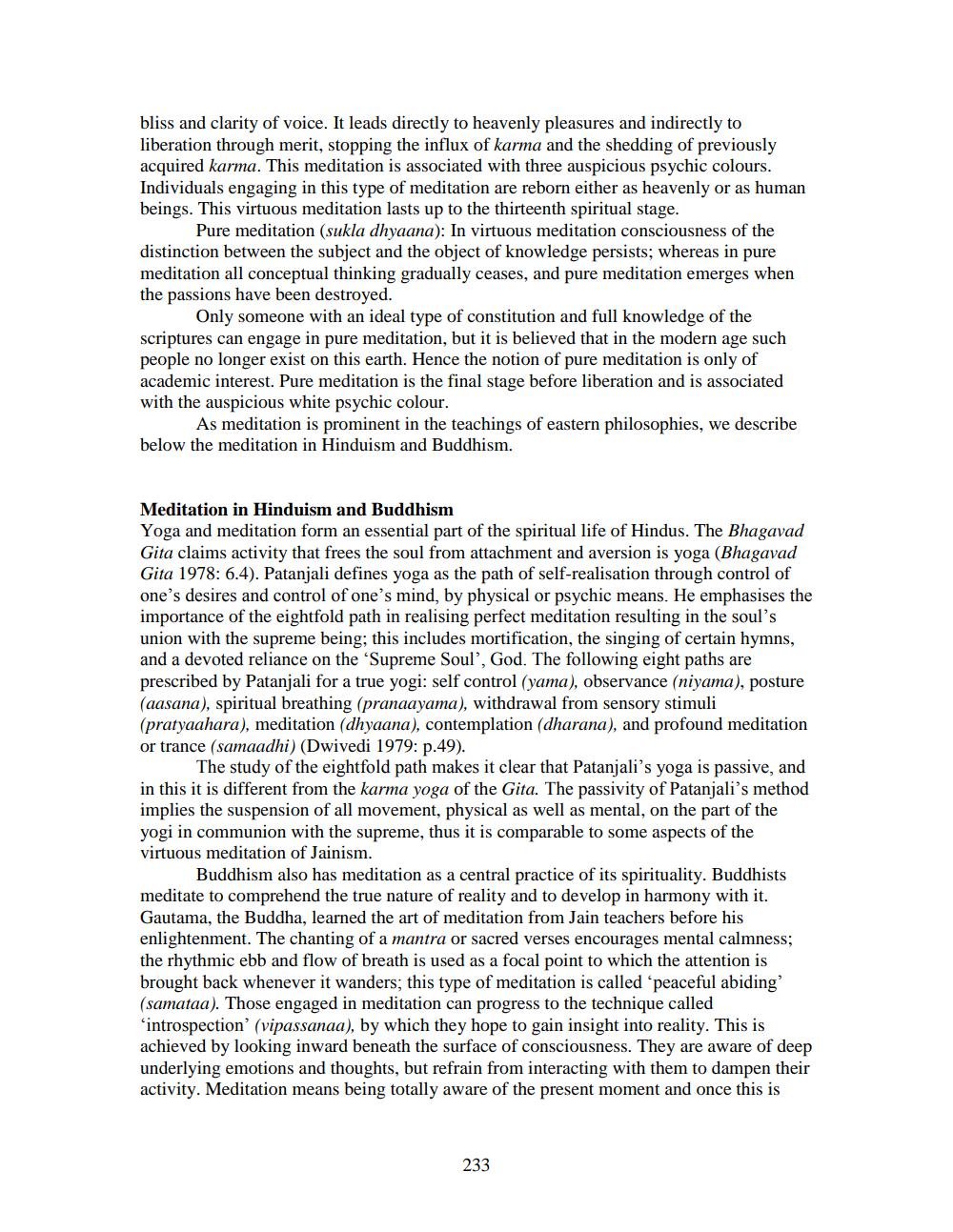________________
bliss and clarity of voice. It leads directly to heavenly pleasures and indirectly to liberation through merit, stopping the influx of karma and the shedding of previously acquired karma. This meditation is associated with three auspicious psychic colours. Individuals engaging in this type of meditation are reborn either as heavenly or as human beings. This virtuous meditation lasts up to the thirteenth spiritual stage.
Pure meditation (sukla dhyaana): In virtuous meditation consciousness of the distinction between the subject and the object of knowledge persists; whereas in pure meditation all conceptual thinking gradually ceases, and pure meditation emerges when the passions have been destroyed.
Only someone with an ideal type of constitution and full knowledge of the scriptures can engage in pure meditation, but it is believed that in the modern age such people no longer exist on this earth. Hence the notion of pure meditation is only of academic interest. Pure meditation is the final stage before liberation and is associated with the auspicious white psychic colour.
As meditation is prominent in the teachings of eastern philosophies, we describe below the meditation in Hinduism and Buddhism.
Meditation in Hinduism and Buddhism Yoga and meditation form an essential part of the spiritual life of Hindus. The Bhagavad Gita claims activity that frees the soul from attachment and aversion is yoga (Bhagavad Gita 1978: 6.4). Patanjali defines yoga as the path of self-realisation through control of one's desires and control of one's mind, by physical or psychic means. He emphasises the importance of the eightfold path in realising perfect meditation resulting in the soul's union with the supreme being; this includes mortification, the singing of certain hymns, and a devoted reliance on the 'Supreme Soul', God. The following eight paths are prescribed by Patanjali for a true yogi: self control (yama), observance (niyama), posture (aasana), spiritual breathing (pranaayama), withdrawal from sensory stimuli (pratyaahara), meditation (dhyaana), contemplation (dharana), and profound meditation or trance (samaadhi) (Dwivedi 1979: p.49).
The study of the eightfold path makes it clear that Patanjali's yoga is passive, and in this it is different from the karma yoga of the Gita. The passivity of Patanjali's method implies the suspension of all movement, physical as well as mental, on the part of the yogi in communion with the supreme, thus it is comparable to some aspects of the virtuous meditation of Jainism.
Buddhism also has meditation as a central practice of its spirituality. Buddhists meditate to comprehend the true nature of reality and to develop in harmony with it. Gautama, the Buddha, learned the art of meditation from Jain teachers before his enlightenment. The chanting of a mantra or sacred verses encourages mental calmness; the rhythmic ebb and flow of breath is used as a focal point to which the attention is brought back whenever it wanders, this type of meditation is called 'peaceful abiding' (samataa). Those engaged in meditation can progress to the technique called 'introspection' (vipassanaa), by which they hope to gain insight into reality. This is achieved by looking inward beneath the surface of consciousness. They are aware of deep underlying emotions and thoughts, but refrain from interacting with them to dampen their activity. Meditation means being totally aware of the present moment and once this is
233




